40 Practical Backyard Garden Beds Ideas for Growing Success
Looking to boost your backyard gardening success? Consider opting for raised garden beds to improve soil management, or try vertical garden beds to maximize your space. Square foot gardening simplifies planning with organized planting areas, while container gardening offers flexibility. For a sustainable approach, hugelkultur beds enrich soil naturally, and zen garden beds provide tranquility. Don’t forget pollinator pathway beds and medicinal herb gardens to enhance biodiversity and wellness. Explore even more innovative ideas to transform your gardening experience!
Raised Garden Beds
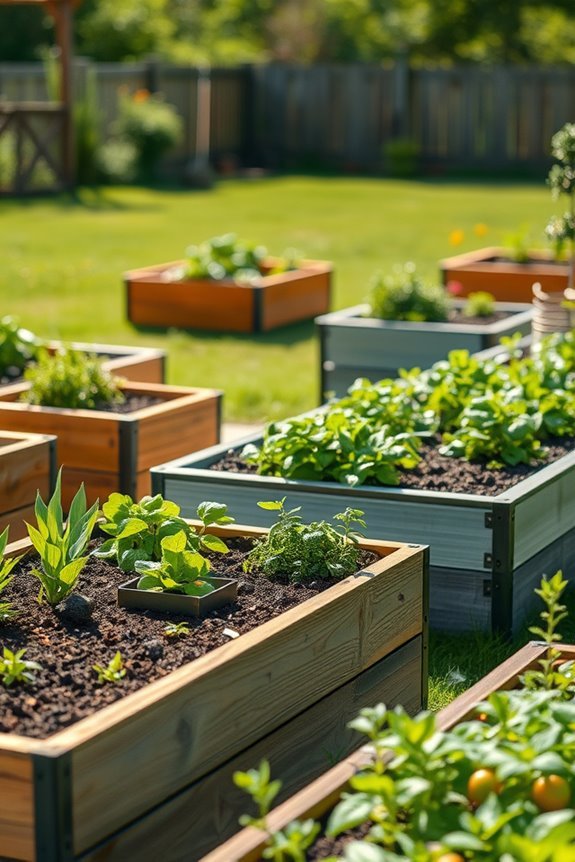
If you’re looking to maximize your gardening space, raised garden beds are a fantastic option. They allow for efficient garden layouts and make it easier to manage soil amendments and composting techniques.
By incorporating seasonal planting and crop rotation, you can enhance plant nutrition and maintain garden sustainability. Use plant companioning strategies to attract beneficial insects and pollinator plants, boosting biodiversity benefits in your yard.
With proper irrigation systems and thoughtful plant spacing, your raised beds can thrive in your specific growing zones. Plus, they can elevate your garden aesthetics and integrate seamlessly into your landscape design.
Don’t forget to explore gardening workshops for tips on garden maintenance, outdoor cooking, and even garden photography to capture your successes!
Vertical Garden Beds
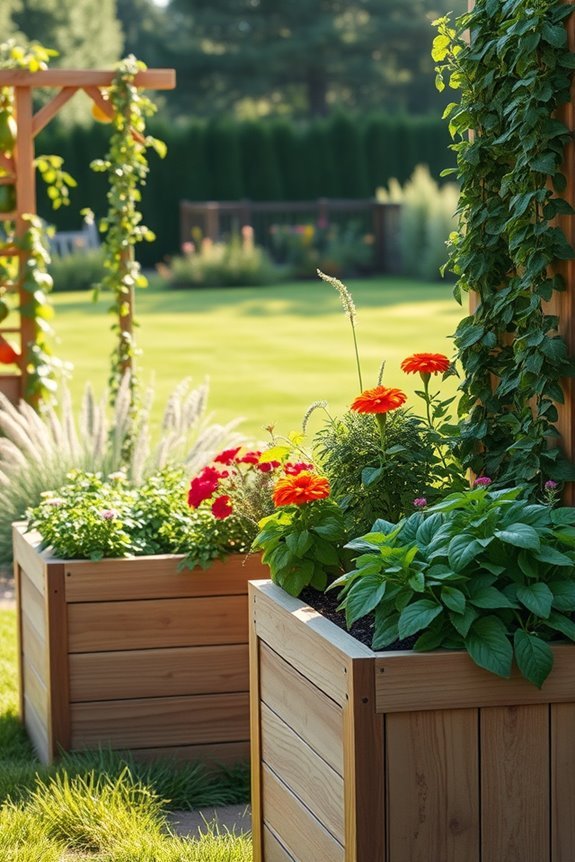
Vertical garden beds can transform even the smallest spaces into lush, vibrant green havens. By utilizing vertical space, you can maximize your garden’s potential.
Wall planters and vertical trellises offer an excellent option for climbing plants, allowing you to create a stunning visual display. Whether you’re into urban gardening or simply want to enhance your backyard’s aesthetic appeal, vertical hydroponics and modular systems can help you achieve your goals.
When planning your vertical garden, pay attention to plant selection to guarantee compatibility and growth success. With the right gardening tools and a little creativity, you can create a thriving vertical garden that not only saves space but also adds a unique charm to your outdoor area.
Square Foot Gardening
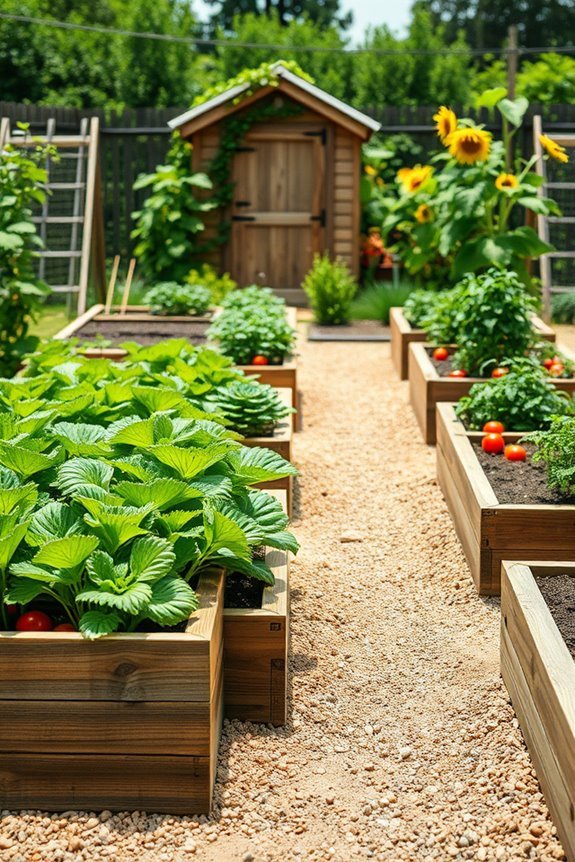
Square foot gardening is an efficient method that maximizes your growing space while minimizing the effort involved in maintaining your garden.
By dividing your garden into small, manageable squares, you can implement square foot strategies that allow for ideal garden spacing. Each square can host different plants, ensuring you make the most of your area.
You’ll find it easier to plan your garden layout, and crop rotation becomes simpler. This method reduces weeds and pests, as densely planted squares can outcompete them.
Plus, it’s perfect for beginners, as you can start small and expand as you gain confidence. With square foot gardening, you’ll enjoy a productive garden without overwhelming yourself.
Container Gardening

Container gardening offers a flexible solution for those looking to grow plants in limited spaces or unconventional locations.
Whether you’re diving into indoor container gardening or exploring vegetable container gardening, you’ll find numerous container gardening benefits, like easy mobility with portable container gardens.
Self-watering containers can simplify your routine, ensuring your plants stay hydrated.
For beginners, starting with herb container gardening is a great choice, as herbs thrive in smaller spaces.
Don’t shy away from decorative container ideas to enhance your garden’s aesthetic!
However, be aware of container gardening challenges, such as drainage and soil quality.
Experiment with seasonal container plants to keep your garden vibrant year-round and enjoy the rewards of your green thumb!
Hugelkultur Beds

If you’re looking for an innovative way to create a sustainable garden bed, Hugelkultur might be just what you need. This technique involves constructing raised beds using decomposing wood and organic materials, which offers numerous hugelkultur benefits.
The hugelkultur design promotes excellent hugelkultur soil health and water retention, reducing the need for frequent hugelkultur irrigation. You can grow a variety of hugelkultur plants, benefiting from nutrient-rich soil as the materials break down.
While hugelkultur maintenance is minimal, it’s essential to understand hugelkultur techniques to maximize its advantages. This method enhances hugelkultur sustainability, allowing environmental benefits while providing an ideal growing environment.
Embrace Hugelkultur, and watch your garden thrive with less effort!
Keyhole Garden
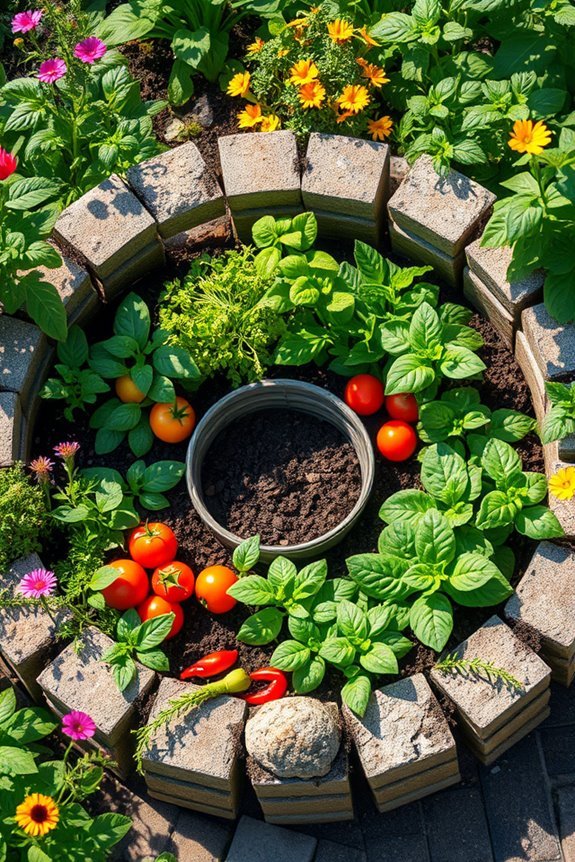
A Keyhole Garden is a unique and efficient gardening method that maximizes space and resources.
This innovative keyhole design features a circular bed with a central compost center that nourishes your plants as it breaks down organic matter. You can easily reach every part of the garden without stepping on the soil, promoting healthy root development.
The compost center not only provides nutrients but also retains moisture, helping your plants thrive in various conditions.
To build one, gather materials like stones or bricks to form the keyhole shape, and fill it with layers of soil and compost.
You’ll be amazed at how much you can grow in this compact, sustainable garden bed!
Straw Bale Gardening

Building on the idea of efficient gardening methods, straw bale gardening offers a simple and effective way to grow plants in limited spaces. This technique involves using bales of straw as planting beds, which provide excellent drainage and insulation for roots.
One of the main straw bale benefits is that it requires less weeding and minimal soil preparation, making it perfect for novice gardeners.
To maintain your straw bales, you’ll need to soak them for a few days to initiate decomposition, then add soil or compost on top for planting. Regular watering is essential, as the bales can dry out quickly.
With proper straw bale maintenance, you can enjoy a bountiful harvest with minimal effort in your backyard garden.
Pallet Garden Beds
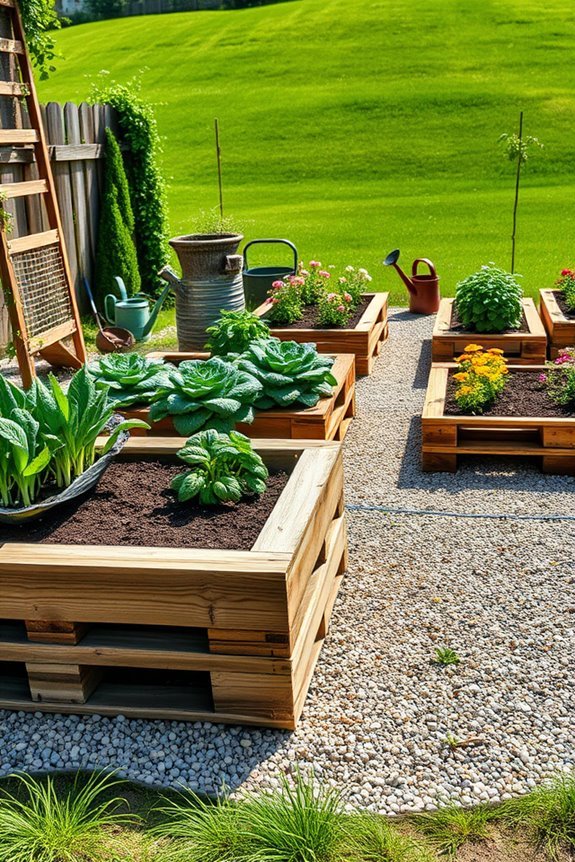
While creating a garden bed from pallets might seem intimidating, it’s actually a fun and rewarding project that can elevate your backyard garden.
Start by gathering sturdy pallets and decide on your pallet design ideas. You can stack them, lay them flat, or even create unique shapes to fit your space. Make certain you treat the wood to prevent rot and pests, then fill your bed with quality soil.
For effective pallet garden maintenance, regularly check for weeds, make certain proper drainage, and water your plants as needed.
You’ll find that pallet beds aren’t only cost-effective but also customizable to your gardening needs. With proper care, these beds can yield a bountiful harvest and add a rustic charm to your outdoor space.
Tiered Garden Beds
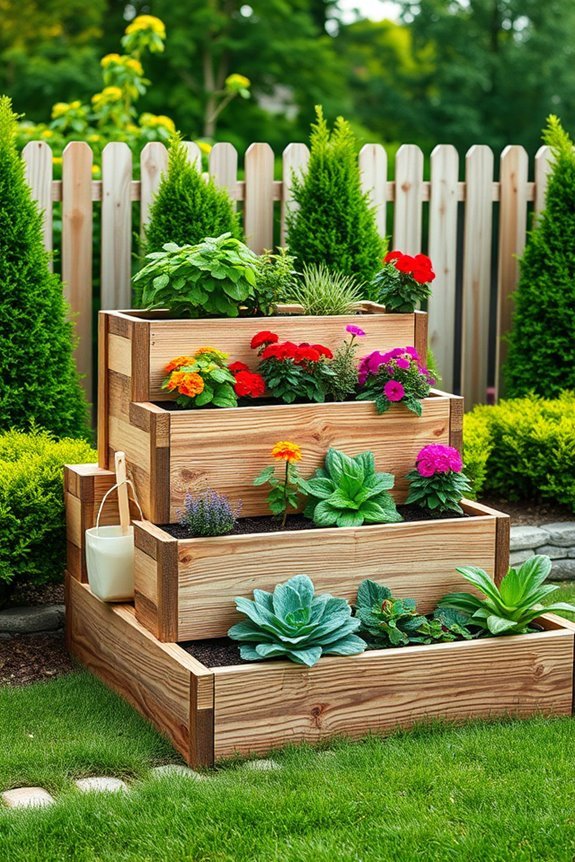
If you’re looking to maximize your gardening space and create a visually appealing layout, tiered garden beds are a fantastic option.
These beds allow for tiered planting, giving you the chance to grow a variety of plants at different heights. This not only enhances aesthetics but also improves sunlight exposure and air circulation.
You can easily incorporate tiered irrigation systems, ensuring that each level receives the right amount of water without waste. By using this method, you can efficiently manage your garden’s resources while promoting healthy plant growth.
Plus, tiered beds can reduce strain on your back, making gardening more enjoyable.
Herb Spiral

After exploring tiered garden beds, consider incorporating an herb spiral into your backyard garden design. This unique structure offers a beautiful way to grow herbs in a compact space.
The herb spiral design features a circular, spiraling raised bed that provides varying microclimates, making it perfect for diverse herbs. You’ll enjoy the spiral garden benefits, such as improved drainage and increased sunlight exposure, which promote healthy growth.
You can plant a variety of herbs, from basil to mint, in this vertical space. Additionally, the design encourages natural pest control and attracts beneficial insects.
Building an herb spiral not only enhances your garden’s aesthetics but also boosts your herb harvest, ensuring you have fresh flavors at your fingertips.
In-Ground Garden Beds
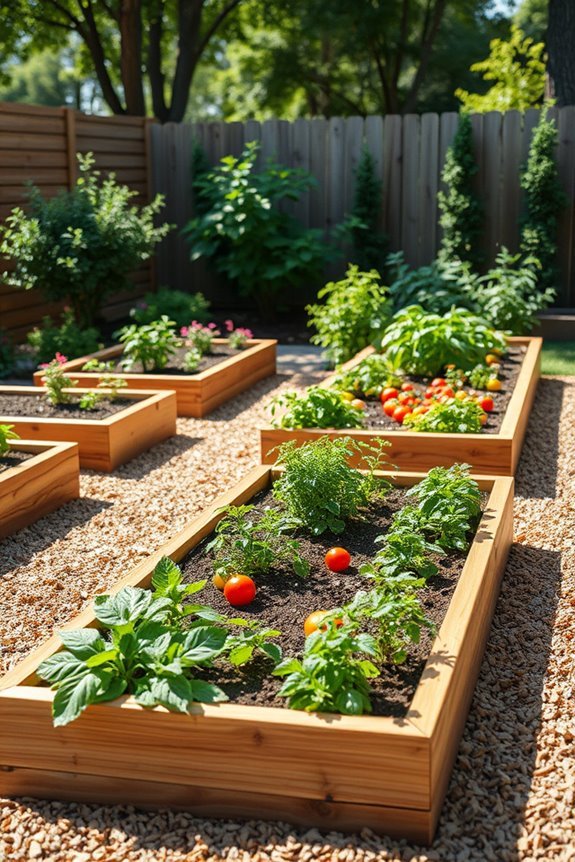
In-ground garden beds are a fantastic option for those looking to cultivate a thriving garden directly in your backyard soil. By utilizing compost layering and soil amendments, you’ll enrich your soil and promote healthy plant growth.
Incorporate organic practices for effective pest management, and consider crop rotation and companion planting to maximize your yield. Pay attention to sunlight exposure and root depth to guarantee your plants thrive.
Seasonal planting can help you take advantage of the best growing conditions throughout the year. Additionally, focus on water conservation techniques to maintain moisture levels in your garden.
With these strategies, you’ll create a productive in-ground garden bed that supports sustainable gardening and enhances your outdoor space.
Wicking Beds
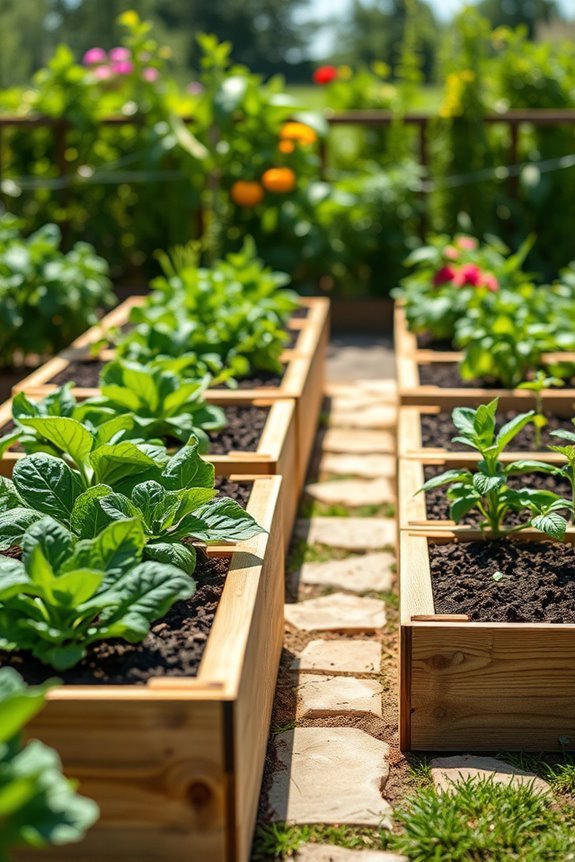
Wicking beds offer an innovative solution for gardeners who want to maximize water efficiency while growing healthy plants.
These self-watering systems use a reservoir at the bottom to promote water retention, ensuring your plants get consistent access to moisture. By utilizing a wicking action, water rises through the soil, keeping the soil moisture at ideal levels without the need for constant watering.
You’ll save time, reduce water waste, and encourage robust root growth. Setting up a wicking bed is simple: layer gravel, a barrier, and your growing medium, and watch your garden thrive with less effort.
With this method, you’ll enjoy a productive garden while conserving resources—perfect for any sustainable gardening enthusiast.
Mobile Garden Beds

If you’re looking for flexibility in your gardening efforts, mobile garden beds might be just what you need.
These versatile beds allow you to move your plants around, adapting to sunlight, weather conditions, or your landscape design. You can try various mobile garden ideas, like using wheeled containers or raised beds on casters, making it easy to shift your garden to the best spot.
The mobile garden benefits include improved accessibility for planting and harvesting, as well as the ability to easily protect your plants from harsh conditions.
Plus, they’re perfect for small spaces or patios where traditional gardening isn’t an option. With mobile garden beds, you can enjoy a dynamic and thriving garden right at your fingertips.
Cinder Block Garden Beds

Cinder block garden beds offer a sturdy and creative solution for gardeners looking to maximize space and improve soil drainage.
With their many cinder block advantages, you can customize cinder block designs to fit your backyard layout. The versatile cinder block arrangements allow for effective cinder block planting while providing excellent cinder block drainage.
Plus, the insulation properties help protect your plants from drastic temperature changes. For better cinder block aesthetics, consider painting or adding plants to the sides.
Remember these cinder block gardening tips: avoid using painted blocks for food crops and guarantee proper cinder block maintenance by checking for cracks.
Ultimately, cinder block sustainability makes this an eco-friendly choice for your garden.
Happy gardening!
Framed Garden Beds

After exploring the benefits of cinder block garden beds, it’s time to contemplate framed garden beds as another fantastic option for your backyard.
These beds enhance your garden aesthetics while providing a defined growing space for your plants. You can choose from various framed bed materials, like wood, metal, or composite. Each material offers unique benefits, such as durability and visual appeal.
Wooden frames can blend beautifully with natural surroundings, while metal frames provide a modern touch.
To get started, make sure your frame is raised enough to allow for proper drainage and soil depth.
Greenhouse Garden Beds

Whether you’re looking to extend your growing season or create a controlled environment for your plants, greenhouse garden beds offer an ideal solution.
By choosing the right greenhouse materials, you can guarantee durability and efficiency. Proper greenhouse ventilation is vital for maintaining peak greenhouse temperature and preventing greenhouse pests.
Don’t forget about greenhouse lighting; it can greatly enhance the growth of your crops. Effective greenhouse insulation helps regulate temperature, while a smart greenhouse layout maximizes space and accessibility.
Implement a consistent greenhouse watering schedule to keep your plants healthy. Regular greenhouse maintenance is fundamental to keep everything running smoothly, making sure your greenhouse garden beds thrive.
With the right setup, you’ll enjoy bountiful harvests year-round!
Lasagna Gardening

If you’re looking for an innovative way to build your garden beds, lasagna gardening might be just what you need. This method involves creating lasagna layers of organic materials, such as leaves, grass clippings, and kitchen scraps, which improve soil health.
By using effective composting techniques, you enhance moisture retention and promote beneficial microbial activity.
Consider your plant selection carefully to guarantee compatibility with seasonal planting and crop rotation. This approach can greatly reduce garden maintenance and pest management challenges.
As the organic materials break down, they create a rich, nutrient-dense environment for your plants. Embrace lasagna gardening to enjoy an eco-friendly, productive garden that thrives with minimal effort.
Compost Garden Beds

Building on the principles of lasagna gardening, compost garden beds offer another effective way to enrich your soil and boost plant growth. You can create these beds by utilizing compost layering, which involves stacking organic materials like kitchen scraps, yard waste, and soil.
Start with coarse materials at the bottom, then alternate layers of greens and browns, finishing with a top layer of finished compost. This process not only improves soil structure but also provides essential nutrients.
To maximize benefits, consider brewing compost tea from your compost pile; this nutrient-rich liquid can be used to water your plants, promoting healthy growth.
With compost garden beds, you’re not just gardening—you’re nurturing a thriving ecosystem.
Cold Frame Beds

Cold frame beds can extend your gardening season and protect your plants from harsh weather, making them a valuable addition to any backyard garden.
These structures utilize various cold frame materials, like wood or PVC, for effective insulation. When considering cold frame placement, choose a sunny spot to maximize warmth.
Opt for a simple cold frame design with a clear lid for easy access and ventilation. It’s essential to monitor cold frame ventilation to prevent overheating.
You can grow a variety of cold frame crops, such as lettuce and spinach, that thrive in cooler conditions.
Regular cold frame maintenance involves checking for pests and ensuring proper insulation.
Enhance your setup with cold frame accessories like thermometers and automatic vents for ideal cold frame gardening success.
Butterfly Garden Beds

Creating a vibrant butterfly garden bed not only enhances your backyard’s beauty but also supports local ecosystems. To attract various butterfly species, incorporate nectar plants like milkweed and coneflowers, which serve as essential food sources.
Focus on habitat creation through thoughtful garden design, using native flowers that thrive in your region. Aim for plant diversity by mixing seasonal blooms, ensuring color schemes appeal to both you and the butterflies.
This diversity encourages wildlife attraction and helps with natural pest control, creating a balanced environment. By planting in clusters, you’ll make it easier for butterflies to find food and shelter.
With a little planning, your butterfly garden bed will become a lively haven for these enchanting creatures.
Pollinator Garden Beds

If you want to boost biodiversity in your backyard, consider establishing a pollinator garden bed.
Focus on native plant selection, as these plants thrive in your local environment and support local wildlife. Incorporate bee-friendly flowers and butterfly-attracting plants to create a vibrant habitat.
Use garden design tips to guarantee a diverse layout that encourages pollinator visits. Implement seasonal planting strategies to keep blooms available year-round, while also including pollinator-friendly herbs that can serve dual purposes in your kitchen.
Don’t forget about pollinator maintenance; regular care will enhance the biodiversity of your space.
Finally, consider attending pollinator education workshops to deepen your understanding and improve your garden’s impact on local ecosystems. Your efforts will surely make a difference!
Shade Garden Beds
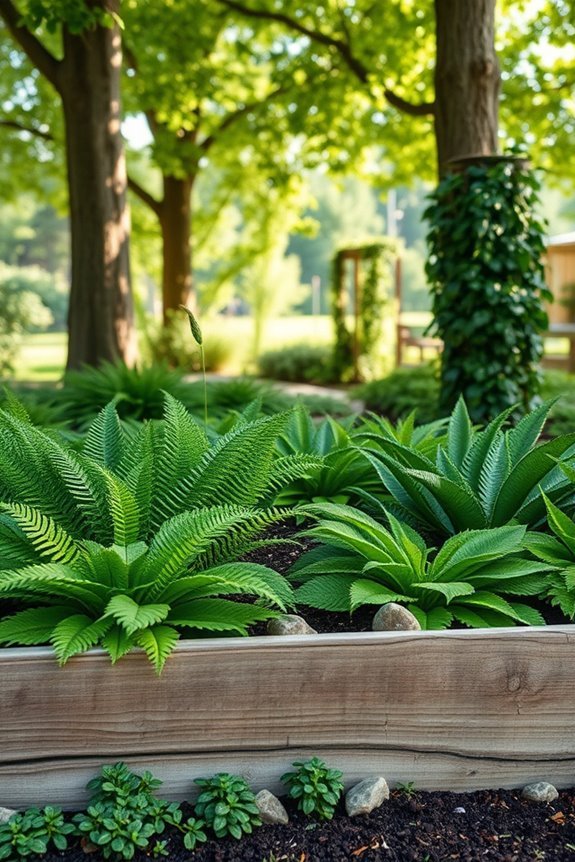
After enhancing your backyard’s biodiversity with a pollinator garden bed, you might find shady corners in need of attention.
Shade garden beds can thrive with the right shade plants that suit your space’s light requirements. Start with thoughtful garden planning, considering soil amendments for moisture retention.
Choose a mix of seasonal blooms to create visual interest while practicing companion planting to enhance pest management. Pay close attention to plant selection, ensuring that each addition contributes to the overall aesthetic appeal.
With careful arrangement and a focus on the unique conditions of your shaded areas, you’ll transform those often-overlooked spots into vibrant, lush retreats that support both beauty and biodiversity in your backyard.
Edible Landscape Beds

While you enjoy the beauty of your backyard, why not incorporate edible landscape beds that provide both aesthetics and fresh produce?
Edible flowerbeds are a fantastic way to blend colors and flavors. Plant vibrant nasturtiums, marigolds, and pansies alongside your vegetables; they’ll attract pollinators and deter pests.
Consider creating fruit tree guilds, where you group fruit trees with companion plants that support their growth. This method enhances biodiversity and maximizes space.
Utilize herbs like basil and mint as ground cover around your trees to improve flavor and health.
With thoughtful planning, you can transform your landscape into a stunning and productive space, ensuring you savor fresh harvests while enjoying a visually appealing garden.
Rain Garden Beds
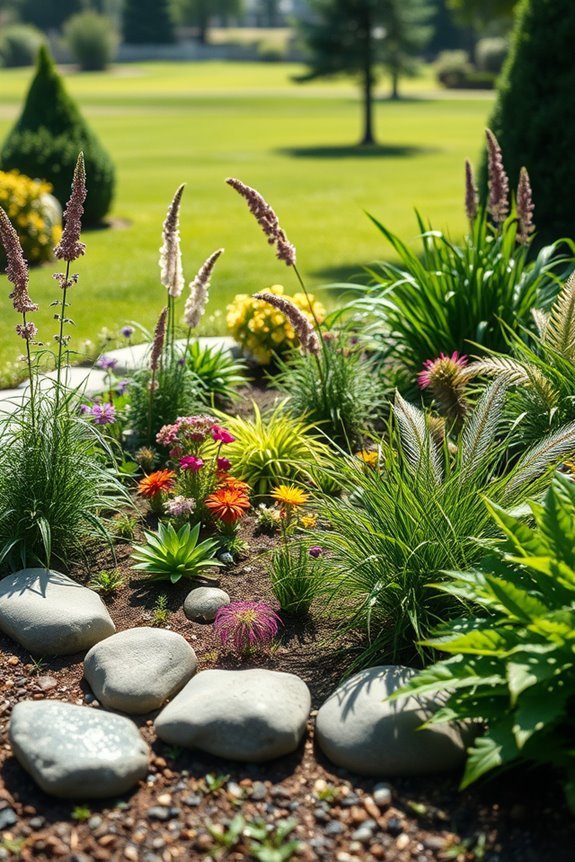
Edible landscape beds not only enhance beauty and provide fresh produce, but they can also improve water management in your garden.
Rain garden beds are perfect for rainwater harvesting, allowing you to manage runoff effectively. Start with thoughtful plant selection by incorporating native plants that thrive in your climate, ensuring seasonal blooms and wildlife attraction.
Enhance your soil with amendments to boost drainage solutions and support sustainable gardening practices. These beds not only capture rainwater but also foster biodiversity benefits, creating a thriving ecosystem.
Regular maintenance practices, like mulching and pruning, keep your rain garden healthy and vibrant. By integrating these elements, you’ll cultivate an efficient and beautiful garden space that benefits both you and the environment.
Perennial Garden Beds
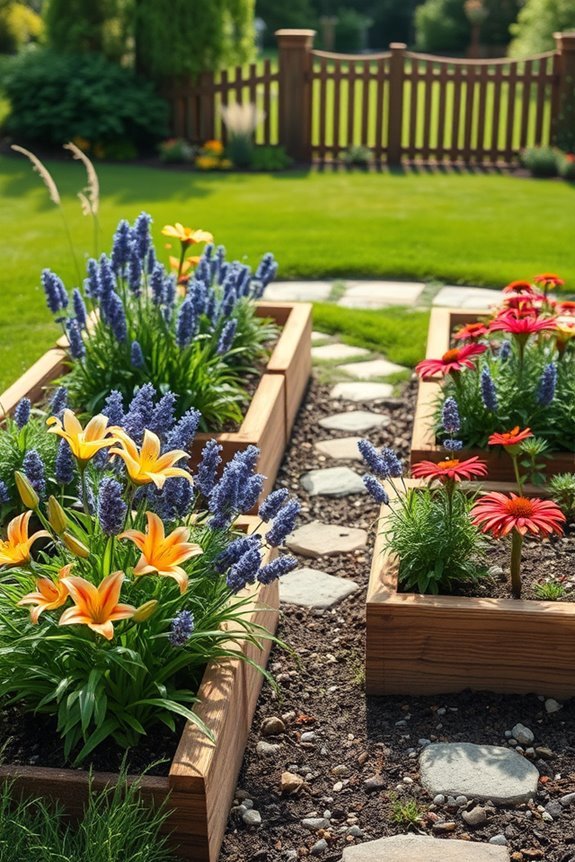
Perennial garden beds are a fantastic way to create a vibrant, low-maintenance landscape that rewards you year after year.
Start with thoughtful perennial plant selection, incorporating native perennial species and drought-tolerant perennials to suit your climate. Choose pollinator-friendly perennials to attract beneficial insects, enhancing your garden’s ecosystem.
Use seasonal perennial blooms to guarantee color throughout the year. Implement companion planting perennials to promote healthy growth and deter pests.
For ideal health, focus on perennial garden maintenance by employing soil amendment strategies that enrich your soil.
Finally, prioritize sustainable perennial practices in your design to minimize environmental impact and support biodiversity.
With these elements, your perennial garden bed can flourish beautifully over time.
Wildlife Habitat Beds
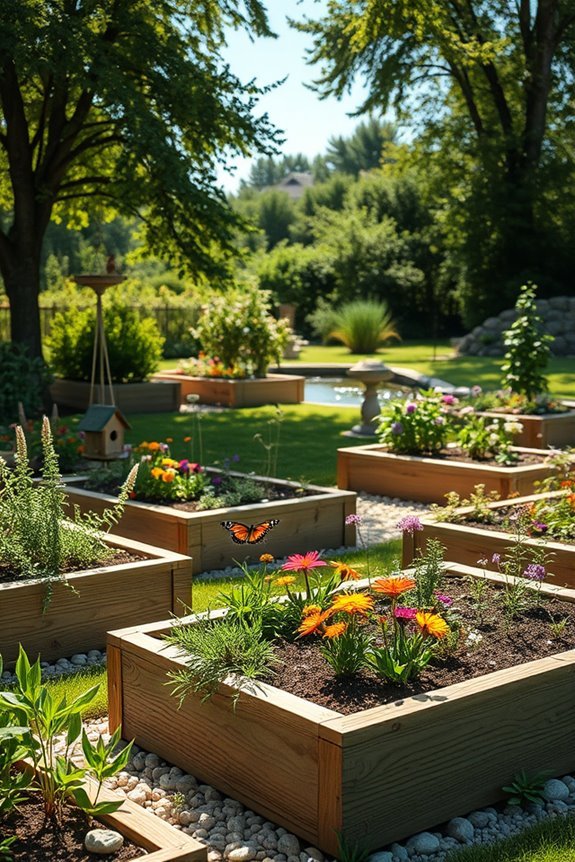
Creating a wildlife habitat bed not only enhances your garden’s beauty but also supports local ecosystems. By focusing on native plant selection, you’ll attract birds, butterflies, and beneficial insects, fostering a thriving environment.
Start your habitat design by selecting plants that are well-suited to your local climate and soil conditions. Incorporate a mix of perennials, shrubs, and trees to provide food and shelter year-round.
Consider adding features like birdhouses, bee hotels, and water sources to encourage diverse wildlife. Avoid using pesticides, as they can harm beneficial species.
Community Garden Beds
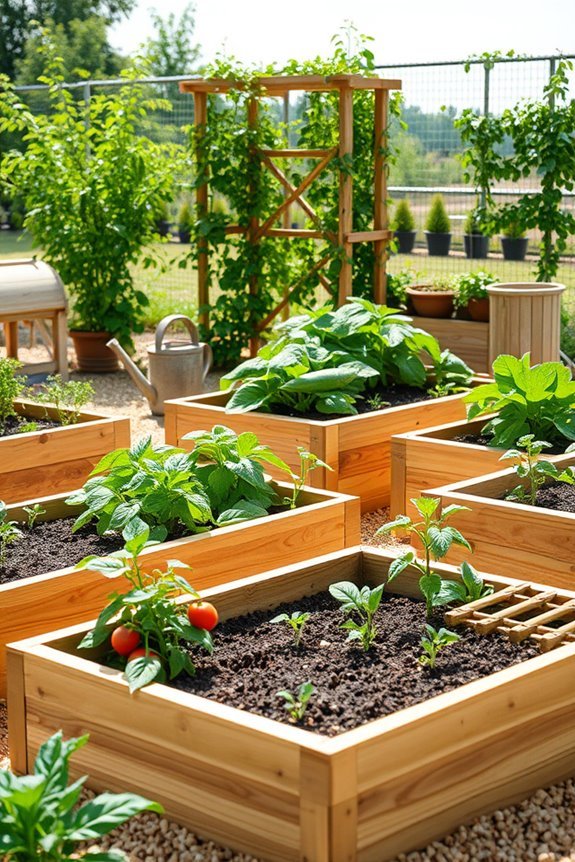
While you might think of your backyard as a personal retreat, community garden beds can transform shared spaces into vibrant hubs of collaboration and growth. By participating in these gardens, you can enhance community involvement and create a sense of belonging.
Engage in planting workshops that teach sustainable practices and effective garden design. Seasonal festivals bring neighbors together to celebrate the harvest and share recipes. Educational programs offer valuable insights into crop rotation and soil health, fostering a deeper appreciation for gardening.
Plus, volunteer opportunities abound, allowing you to connect with local partnerships and contribute to community outreach. Together, you’ll cultivate not just plants, but friendships and knowledge, making your community garden a thriving asset for everyone involved.
Children’s Garden Beds

If you want to inspire a love of gardening in children, designing dedicated children’s garden beds can make all the difference.
These spaces can serve as a platform for children’s gardening, where they can learn about plants and nature exploration. Incorporate interactive planting techniques and sensory experiences, using vibrant flowers and fragrant herbs.
Engage them in educational gardening by discussing plant life cycles and garden responsibilities. You can also integrate seasonal activities and planting games to keep their interest alive.
Encourage creativity with garden crafts, making it a fun family bonding experience. By fostering a hands-on approach, you’ll not only cultivate their gardening skills but also create lasting memories together in your backyard.
DIY Garden Beds

Building DIY garden beds can transform your backyard into a thriving oasis, allowing you to customize the space to suit your gardening needs.
With a variety of garden bed designs, you can create raised beds, tiered gardens, or even vertical setups depending on your available space and preferences. Using simple DIY garden tools, you can easily construct these beds from materials like wood, concrete blocks, or metal.
Start by determining the size and shape that fits your garden layout. Don’t forget to take into account drainage and soil depth for ideal plant growth.
As you build, you’ll not only enhance your garden’s aesthetics but also enjoy the satisfaction of creating your own productive gardening haven.
Happy gardening!
Recycled Material Garden Beds

Using recycled materials for garden beds not only promotes sustainability but also adds a unique character to your backyard. You can create stunning tire garden beds or use upcycled wood to build raised beds that stand out.
Consider turning old furniture into charming planters or using concrete blocks for a modern look. Metal scrap can form creative garden fencing, while wooden pallets can be transformed into vertical gardens.
Don’t forget about plastic containers—they’re perfect for smaller spaces. For a rustic touch, you might stack brick walls or use glass bottles as borders.
Each option allows you to express your style while benefiting the environment, making your garden both practical and visually appealing.
Sunken Garden Beds

Sunken garden beds offer a creative way to enhance your landscape while providing excellent drainage and soil conditions for your plants.
The benefits of sunken beds include improved moisture retention and easier access for planting and harvesting. When designing your sunken bed, consider materials like stone or wood for durability.
Proper placement guarantees ideal sun exposure and irrigation efficiency. Sunken beds can accommodate a variety of crops, from vegetables to flowers, enhancing the aesthetics of your garden.
Maintenance is simple, focusing on soil health and drainage. With thoughtful planting and innovative designs, you’ll enjoy the advantages of sunken beds for years to come.
Their unique style and practicality make them a fantastic addition to any backyard.
Glazed Pot Garden Beds

Glazed pot garden beds bring a splash of color and style to your outdoor space, making them a delightful choice for plant lovers. Available in various sizes and materials, these pots can suit any garden aesthetic.
When choosing glazed pot varieties, consider their drainage; make sure you drill holes if needed. Proper glazed pot placement is essential, as they’ll thrive in sunlight but may require shade during the hottest hours.
Maintenance is simple—just clean the exterior and check for moisture. The vibrant aesthetics of glazed pots enhance your garden’s appeal, while their benefits include improved insulation for roots.
With the right choices, you can create a stunning display that showcases your favorite plants beautifully.
Herb Garden Beds

Herb garden beds can transform your backyard into a fragrant haven, inviting you to explore a world of culinary possibilities. You can grow a variety of culinary herbs, from basil to rosemary, enhancing your meals with fresh flavors.
Consider incorporating medicinal plants alongside your aromatic herbs for added benefits. When designing your herb garden, think about herb companions that thrive together, maximizing your space.
Indoor herb gardens are also an option for year-round freshness. With proper herb propagation techniques, you can expand your garden easily.
Regular herb garden maintenance guarantees your plants stay healthy. Finally, embrace herb preservation methods like drying or freezing to enjoy your harvest long after the growing season ends.
Enjoy the many herb garden benefits today!
Vegetable Garden Beds
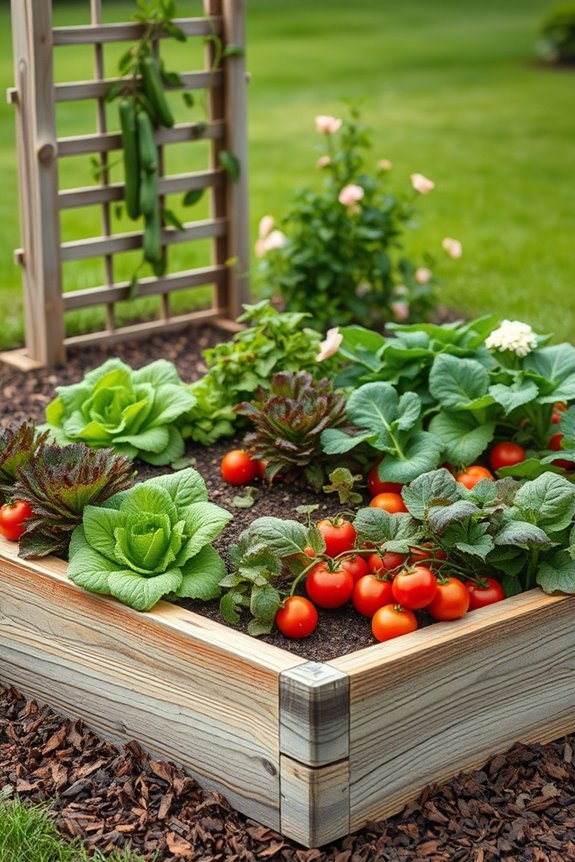
Creating vegetable garden beds can be a rewarding experience, allowing you to grow your own fresh produce right at home.
Start by planning your garden layout, considering sun exposure and plant spacing. Use organic methods like companion planting to enhance soil health and promote plant diversity. Incorporate heirloom varieties for unique flavors and traditional gardening practices.
Seasonal planting is key; rotate crops yearly to prevent soil depletion and manage pests naturally. Employ mulching benefits to retain moisture and suppress weeds. Be mindful of watering techniques to guarantee even moisture across beds.
As harvest time approaches, use transplanting tips and seed saving to maintain your garden’s liveliness. With regular garden maintenance, you’ll enjoy a bountiful harvest while practicing organic pest management.
Flower Garden Beds

While planning your flower garden beds, consider the colors, textures, and heights of the plants you want to include. Use flower color combinations to create visually appealing layouts that align with your chosen flower garden themes.
Implement flower selection tips to guarantee a vibrant display throughout the seasons with seasonal flower planting. For an effective flower bed design, incorporate flower companion planting techniques to enhance growth and reduce pests.
Regular flower bed maintenance, including flower bed mulching, will keep your garden healthy and looking great. Explore flower arrangement ideas for cut flowers and utilize flower propagation techniques to expand your collection.
With these strategies, you’ll cultivate a stunning and thriving flower garden that reflects your personal style.
Sensory Garden Beds
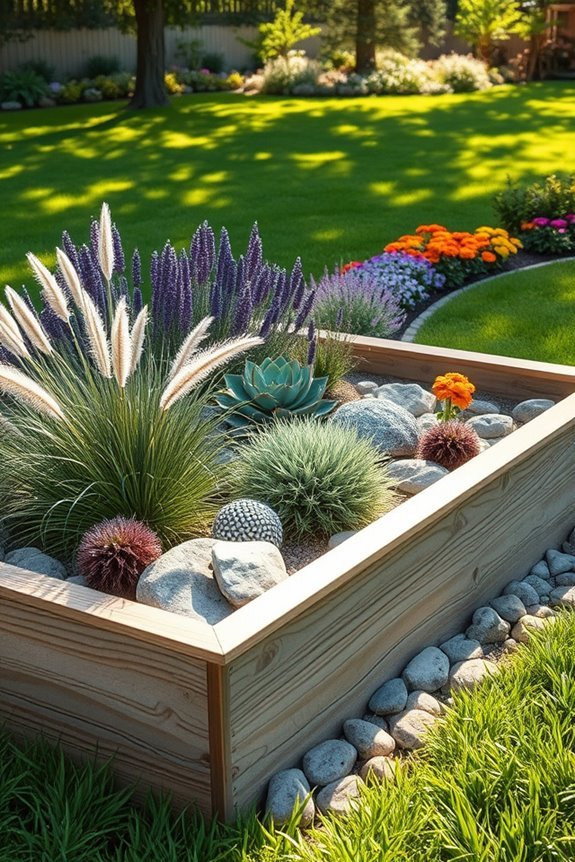
Sensory garden beds invite you to engage with nature through sight, sound, touch, smell, and taste.
These vibrant spaces create sensory stimulation, helping you experience the garden in new ways. Incorporate aromatic plants like lavender and mint to fill the air with delightful scents.
Mix textured surfaces—smooth stones, soft moss, and rough bark—to enhance tactile experiences. Use color contrasts, from bright flowers to lush greens, to catch your eye.
Add sound elements, like wind chimes or rustling grasses, for an auditory delight. Plant edible flowers like nasturtiums and incorporate interactive features, such as sensory pathways that encourage exploration.
Sensory play becomes an adventure, making your garden a dynamic environment for all ages.
Zen Garden Beds

Zen garden beds offer a tranquil retreat, inviting you to find peace and mindfulness in your outdoor space. By incorporating a minimalist approach, you can create a serene environment that encourages relaxation.
Use natural elements like rock features and gentle textures to enhance your meditation space. Plant tranquility plants such as bamboo or ornamental grasses to add calming colors and movement.
Mindfulness gardening in these beds allows you to focus on each element, cultivating a deeper connection with nature. Arrange stones and gravel to create patterns that promote contemplation.
As you care for your zen garden, you’ll find it becomes a peaceful retreat, a sanctuary that nurtures your spirit and encourages a sense of harmony in your life.
Pollinator Pathway Beds
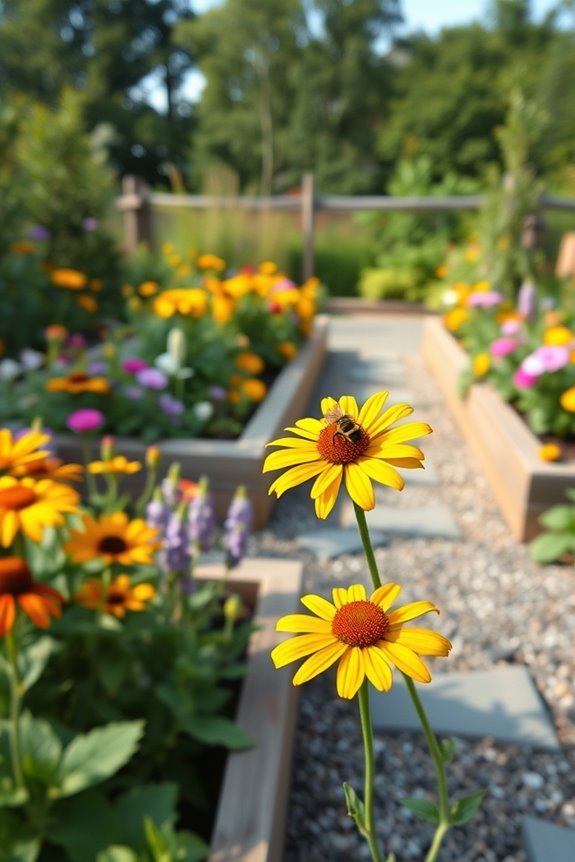
Have you ever considered how a pollinator pathway bed can transform your garden into a vibrant ecosystem?
By incorporating native plants and bee-friendly flowers, you’ll create a thriving pollinator habitat that attracts butterflies and supports diverse flora.
Your garden design can embrace sustainable gardening principles by selecting plants that bloom in different seasons, ensuring a constant food source for these essential creatures.
As you cultivate a pollinator-friendly space, you’re also contributing to habitat restoration, helping to reverse the decline of pollinator populations.
With careful planning and a focus on seasonal blooms, your pathway bed won’t only be beautiful but will also play a critical role in supporting our environment.
Medicinal Herb Garden Beds

Creating a pollinator pathway bed not only enhances your garden’s biodiversity but can also lead you to explore the world of medicinal herb garden beds.
These beds can provide a bounty of herbal remedies, supporting natural healing and wellness gardening. Start by researching plant benefits and medicinal uses of seasonal herbs like chamomile and peppermint.
Utilize effective cultivation techniques to maximize growth and guarantee a continuous supply for your herbal teas and essential oils. As you plan your garden, consider integrating these herbs into your landscape design, creating both beauty and functionality.
With thoughtful garden planning, you’ll enjoy the rewards of your medicinal herb garden, enriching your life with nature’s healing properties.
Seasonal Rotation Garden Beds

As you plan your garden, incorporating seasonal rotation garden beds can greatly enhance your soil health and crop yield.
By practicing crop rotation, you’ll prevent nutrient depletion and reduce pest and disease issues. Start by dividing your garden into sections, dedicating each to a specific type of plant for the season.
For instance, you might grow legumes in one bed in spring, followed by leafy greens in summer, and root vegetables in fall. This method of seasonal planting not only improves soil structure but also maximizes your harvest throughout the year.
Remember to keep track of what you plant where, ensuring a balanced approach that promotes biodiversity and sustainability in your backyard garden.
Happy gardening!
Conclusion
With so many creative backyard garden bed ideas at your fingertips, you’re sure to find the perfect fit for your space and needs. Whether you opt for raised beds, vertical setups, or even container gardening, each method offers unique benefits that can lead to a bountiful harvest. Don’t hesitate to experiment with different styles like hugelkultur or medicinal herb beds. Your gardening journey is just beginning, and there’s no limit to what you can grow!







